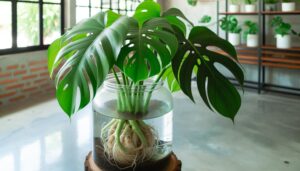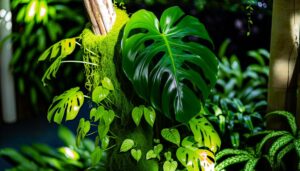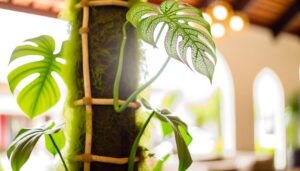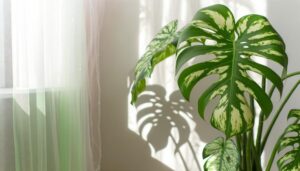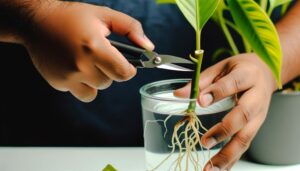Monstera Lechleriana Watering Tips
Water your Monstera Lechleriana when the top inch of soil feels dry. Use well-draining soil and pots with drainage holes to avoid waterlogging.
Overwatering can cause yellow leaves and mushy stems, so monitor with a moisture meter. In winter, reduce watering, but in warmer months, you may need to increase it.
Maintain humidity levels between 60-80% with a humidifier or pebble tray. Look out for signs of underwatering like wilting or crispy edges.
Consistent monitoring and adjustments will keep your plant thriving. Ready to optimize your care routine even further?
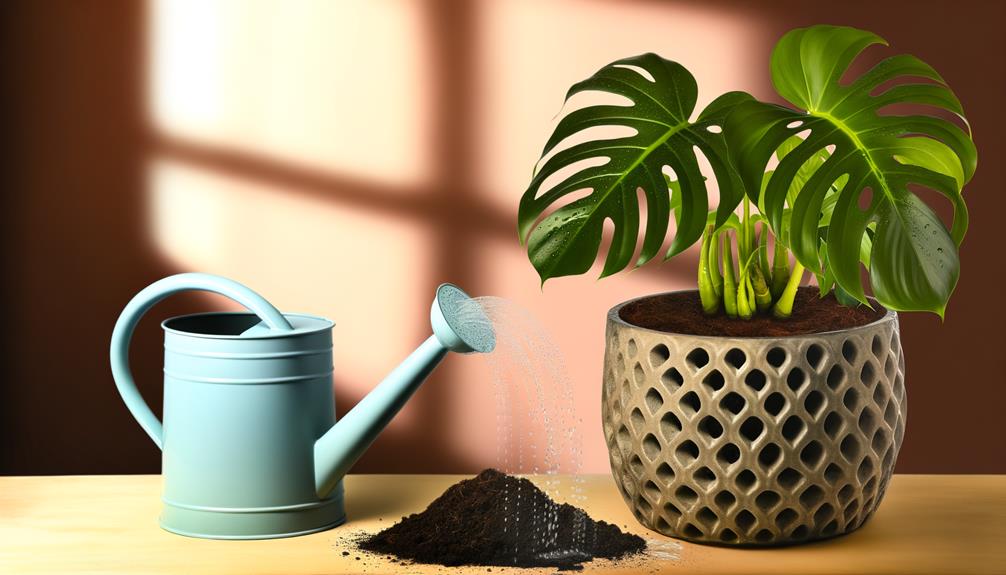
Key Takeaways
- Use well-draining soil and a pot with drainage holes to prevent waterlogging.
- Water when the top inch of soil is dry; reduce frequency in winter.
- Maintain humidity levels between 60-80% using a humidifier or pebble tray.
- Yellowing leaves and mushy stems are signs of overwatering; adjust watering accordingly.
- Group plants together or mist regularly to maintain humidity.
Understanding Water Needs
To properly care for your Monstera Lechleriana, you need to understand its unique water requirements to guarantee ideal growth.
This tropical plant thrives in well-draining soil, which prevents root rot by ensuring excess water doesn't linger. It's essential to monitor the top inch of soil; when it feels dry to the touch, it's time to water. Overwatering can lead to yellowing leaves and mushy stems, so keep an eye out for these signs.
Humidity levels also play a role. Aim for a humid environment, ideally between 60-80%, to mimic its natural habitat. You can use a humidity tray or a room humidifier.
Best Watering Schedule
Crafting the best watering schedule for your Monstera Lechleriana involves understanding the plant's natural growth cycles and your home's specific environment. Typically, you'll want to water when the top two inches of soil feel dry. Consistency is key, so check the soil moisture regularly. Adjust your schedule based on seasonal changes and indoor conditions.
Consider the following tips:
- Use a moisture meter to accurately gauge soil dryness.
- Water less in winter, as the plant's growth slows down.
- Increase humidity with a humidifier or misting, especially in dry climates.
- Ensure proper drainage by using well-draining soil and pots with holes.
- Monitor plant health to adjust watering frequency as needed.
Signs of Overwatering
You'll know you've overwatered your Monstera Lechleriana if its leaves start turning yellow, which is a clear sign of distress.
Additionally, keep an eye out for root rot, characterized by mushy, dark roots and a foul odor.
Catching these symptoms early can save your plant from severe damage.
Yellowing Leaves Indication
Yellowing leaves on your Monstera Lechleriana often signal overwatering, a common issue that can stunt growth and lead to root rot if not addressed promptly. When you notice yellowing, it's essential to evaluate your watering habits and adjust accordingly.
To help you identify and remedy this problem, consider these practical tips:
- Check soil moisture: Use your finger or a moisture meter to confirm the top inch of soil is dry before watering.
- Improve drainage: Make certain your pot has drainage holes and use well-draining soil.
- Adjust watering schedule: Water less frequently, especially during cooler months.
- Monitor humidity: High humidity can contribute to overwatering symptoms; maintain balanced levels.
- Inspect the pot size: Make sure your plant isn't in a pot that's too large, which can retain excess moisture.
Root Rot Symptoms
How can you tell if your Monstera Lechleriana is suffering from root rot due to overwatering? Look for these key symptoms:
- Mushy Roots: Healthy roots are firm and white or light tan. If they're mushy and brown, it's a clear sign of root rot.
- Foul Smell: A rotting smell from the soil often indicates decaying roots.
- Wilting Leaves: Despite wet soil, leaves may wilt and turn yellow or brown.
Here's a quick reference table to help you identify root rot symptoms:
| Symptom | Healthy Roots | Root Rot Signs |
|---|---|---|
| Root Appearance | Firm, white/light tan | Mushy, brown |
| Smell | None or earthy | Foul, decaying odor |
| Leaves | Green and vibrant | Yellowing, wilting |
Ensure you adjust watering habits promptly to prevent further damage.
Signs of Underwatering
Wilting leaves are one of the most telling signs that your Monstera Lechleriana might be suffering from underwatering. If you notice the plant's leaves drooping or curling, it's time to check the moisture level in the soil.
Yellowing leaves can also indicate a lack of water, as the plant struggles to maintain its health. Additionally, dry and crispy leaf edges are a clear sign of dehydration.
Look out for these symptoms:
- Wilting or drooping leaves
- Yellowing leaves
- Crispy, brown leaf edges
- Stunted growth
- Soil pulling away from the pot's edges
Regularly monitor your plant and adjust your watering routine accordingly to keep your Monstera Lechleriana thriving.
Seasonal Watering Adjustments
Adjusting your Monstera Lechleriana's watering schedule according to the changing seasons is essential to ensure its best health and growth. During the warmer months, your plant will likely need more frequent watering due to increased evaporation and growth rates. Check the soil every few days and water when the top inch feels dry.
Conversely, in the cooler months, the plant's growth rate slows, and evaporation decreases. You should reduce the watering frequency, ensuring the soil dries out more between waterings to prevent root rot. Always monitor the plant closely; its environment might still affect watering needs.
Ideal Water Temperature
While adjusting your Monstera Lechleriana's watering schedule is essential, it's equally important to use water at the right temperature to promote peak health. Aim for room-temperature water, around 65-75°F (18-24°C), to prevent shocking the roots. Cold water can stunt growth and cause root damage, while hot water might scald the plant.
Here are some practical tips to make sure you're using the ideal water temperature:
- Test with your wrist: Water should feel neither cold nor hot.
- Avoid extremes: Don't use water straight from the tap if it's too cold or hot.
- Store water: Let tap water sit out overnight to reach room temperature.
- Use a thermometer: Ensure accurate readings.
- Consistency matters: Always aim for the same temperature range.
Using Filtered Water
For best growth, use strained water to avoid exposing your Monstera Lechleriana to harmful chemicals and impurities commonly found in tap water. Chlorine, fluoride, and heavy metals can stress your plant and hinder its development. Strained water ensures a cleaner, purer option, promoting healthier foliage and robust growth.
Here's a quick comparison to understand better:
| Water Type | Impact on Monstera Lechleriana |
|---|---|
| Tap Water | Contains chlorine, fluoride, and heavy metals that can stress the plant. |
| Strained Water | Reduces harmful chemicals, promoting healthier growth. |
| Distilled Water | Lacks minerals, not ideal for long-term use. |
| Rainwater | Natural option, rich in nutrients, but availability can be inconsistent. |
Using strained water is a practical step for maintaining your Monstera Lechleriana's essentiality.
Soil Moisture Levels
Maintaining the right soil moisture levels is essential for the health and well-being of your Monstera Lechleriana. You'll want to keep the soil consistently moist but not waterlogged.
To achieve this balance, you need to monitor soil conditions regularly. Here are practical tips to guarantee your plant thrives:
- Check soil moisture: Use your finger or a moisture meter to gauge if the top two inches of soil are dry before watering.
- Water frequency: Typically, once a week is sufficient, but adjust based on your plant's needs and environment.
- Humidity: High humidity levels help maintain soil moisture. Mist the leaves to boost humidity.
- Pot size: Ensure the pot isn't too large; it can retain excess water.
- Soil mix: Use a well-draining mix with ingredients like perlite or orchid bark.
Proper Drainage Techniques
To guarantee your Monstera Lechleriana thrives, you'll need to choose a pot with adequate drainage holes and use a well-draining soil mix.
A breathable pot, like one made of terracotta, helps prevent water from pooling at the roots.
Additionally, using a soil mix with perlite or orchid bark can improve aeration and drainage, keeping your plant healthy.
Choosing Right Pot
Selecting the right pot for your Monstera Lechleriana involves making sure it has excellent drainage to prevent water from stagnating around the roots. Proper drainage is vital to avoid root rot and keep your plant healthy.
When choosing a pot, consider these practical tips:
- Drainage holes: Make sure the pot has multiple drainage holes at the bottom.
- Material: Opt for terracotta or ceramic pots, as they allow better air circulation.
- Size: Choose a pot that's slightly larger than the root ball to promote healthy growth.
- Saucer usage: Use a saucer to catch excess water, but don't let the pot sit in it.
- Elevated pots: Consider pots with built-in feet or use pot feet to elevate and improve drainage.
These choices help your Monstera thrive!
Soil Type Matters
Securing your Monstera Lechleriana thrives starts with choosing the right soil type that promotes excellent drainage. Use a mix of peat, perlite, and pine bark to create an airy, well-draining environment. Peat retains moisture without becoming waterlogged, while perlite and pine bark guarantee proper aeration, preventing root rot.
Avoid dense, clay-heavy soils as they retain too much water and suffocate roots. Add a layer of gravel or small stones at the bottom of the pot to further improve drainage. When watering, let excess water escape through the drainage holes. Consistently check soil moisture levels; the top inch should be dry before the next watering. This approach will keep your Monstera's roots healthy and your plant flourishing.
Humidity Requirements
Maintaining high humidity levels is essential for the health and growth of your Monstera Lechleriana. This tropical plant thrives in environments with humidity levels between 60% to 80%.
If the air in your home is too dry, you might notice curled leaves or brown edges. Here are some practical tips to keep the humidity levels just right:
- Group Plants Together: Plants naturally release moisture, so clustering them can create a more humid microenvironment.
- Use a Humidifier: A reliable way to maintain consistent humidity levels.
- Mist Regularly: Spraying the leaves with water can help, but be cautious of overdoing it.
- Place on a Pebble Tray: Elevate the plant above water-filled pebbles to increase humidity.
- Bathrooms: Consider placing your Monstera in a bathroom with good light.
Watering Tools to Use
To guarantee your Monstera Lechleriana thrives, you'll need the right watering tools. Consider using a watering can with a long spout for precision. A soil moisture meter can help monitor hydration levels. Self-watering pots are also beneficial for consistent moisture. Each of these tools can help maintain ideal soil conditions, preventing over or under-watering.
Best Watering Can Types
Selecting the right watering can for your Monstera Lechleriana is crucial, as it ensures even distribution and prevents overwatering. You want a can that offers precision and control. Here are five types to ponder:
- Long Spout Watering Can: Perfect for reaching deep into the foliage, ensuring water reaches the soil without wetting the leaves.
- Narrow Spout Can: Provides a controlled flow, ideal for avoiding waterlogging.
- Haws Watering Can: Known for its fine, even spray, making it excellent for delicate plants.
- Plastic Watering Can: Lightweight and durable, great for everyday use.
- Copper Watering Can: Adds a touch of style while being resistant to rust, ensuring longevity.
Choose one that fits your needs for the best plant health.
Soil Moisture Meters
A soil dampness meter is an invaluable tool for ensuring your Monstera Lechleriana gets just the right amount of water, preventing both overwatering and underwatering. With a quick insert into the soil, you'll get an instant reading, usually on a scale from dry to wet.
This tool takes the guesswork out of watering, allowing you to know exactly when your plant needs hydration. Look for meters with clear, easy-to-read displays and durable probes. Regularly check multiple spots around the root zone for a thorough moisture assessment.
Self-Watering Pots
Self-watering pots can greatly simplify the watering routine for your Monstera Lechleriana, maintaining consistent moisture levels without constant attention. These pots are designed with a reservoir at the base that provides water to the plant as necessary. This method mimics the natural environment where roots can draw water from deeper soil layers.
Here are some practical benefits:
- Consistent Moisture: Maintains your Monstera never dries out or becomes waterlogged.
- Reduced Maintenance: Less frequent watering means less time spent monitoring soil moisture.
- Root Health: Promotes healthier root growth by preventing overwatering.
- Convenience: Ideal for busy lifestyles or frequent travelers.
- Water Conservation: Minimizes water waste by providing only what the plant needs.
Using self-watering pots can make caring for your Monstera Lechleriana much more manageable.
Common Mistakes to Avoid
Overwatering is one of the most common errors you can make when caring for a Monstera Lechleriana. This plant prefers its soil to dry out slightly between waterings. If the soil remains soggy, the roots can rot, leading to yellowing leaves and stunted growth. Always check the top inch of soil before watering; if it's dry, it's time to water.
Another mistake is using a pot without drainage holes. Without proper drainage, excess water sits at the bottom, causing root rot.
Also, avoid placing your Monstera in direct sunlight; it thrives in bright, indirect light.
Finally, don't forget to adjust watering frequency according to the season—less in winter, more in summer.
Following these tips guarantees a healthy, vibrant plant.
Conclusion
You've got the know-how to keep your Monstera lechleriana thriving! Just remember, balance is key—don't drown it or leave it parched.
With the right schedule, proper drainage, and a keen eye for signs, your plant will flourish like a green beacon in your home.
Think of it as a dance, where each step—whether watering, adjusting for seasons, or checking humidity—keeps your leafy partner in perfect harmony.
Happy gardening!


